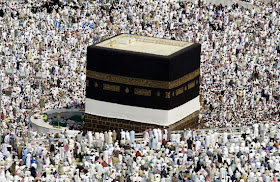
The Muhuarram Festival, c. 1795 Image taken from:www.columbia.edu
Yesterday or today, depending on whether you’re Sunni or Shiite {see wgaw: creeds of islam}, was/is New Year’s Day and the first day of the Islamic year, 1430 H {see wgaw: calendars}.
Muharram is the first month of the Islamic calendar and can also be spelt; Muharam, Moharam or Moharram, but all four versions are said in exactly the same way [moo-ha-rram].
On the 10th day of Muharram, a day of mouring known as Ashora, (also spelt Ashura, but said in exactly the same way [ash-shore-rrah], from the Arabic word for '10'; ash-rra), Shiia Muslims mourn the anniversary of the Battle of Karbala (a town about 100km south-west of Baghdad).
At the Battle of Karbala, Hussain ibn Ali (a grandson of the Prophet Mohammed, founder of Islam) and approximately 72 members of his immediate family and followers were killed, en masse in AD 680 / 61 H. It is said the survivors, mostly women and children, were transported to Damascus where they were incarcerated.

Photograph of a Muharram procession in Baroda (Vadodara) taken by an unknown photographer in c. 1880 Image taken from: http://www.bl.uk/onlinegallery
The Battle of Karbala is marked throughout the Shi'ia world during the first 10 days of Muharram with entire male populations of villages marching as one, in commemeration. Horses often lead the procession and are decorated with green and gold garlands around their necks.

Muharram in Bahrain, 2005.
Image taken from: www.wikimedia.org
The horses are closely followed by several drummers and men carrying various portable loud speakers, on which the story of the battle is re-told to the audience. Highly decorated tazivas [taa-zee-vaas] or lifesize replicas of the martyr’s coffin can follow and are carried through the streets on the shoulders of the mourners.

Muharram in Bahrain, 2005. Image taken from: www.wikimedia.org
Next come the mourners, all male and all of whom will be dressed from head to toe in the black of mourning. They will, in unison, beat their breasts, arms and backs with their right arm. Alternatively sharp knives, 'cats of nine tails' [sun-gal] and swords [safe] are used to draw blood.
~As an aside, the only time I spectated at a Muhrram procession many years ago, there appeared to be a lot of slashing, blood and I found the smell quite overpowering (embarassingly, I fainted). So I have dilerately choosen not to add photos of bodies being cut with sharp implements to this particular blog, however, hundreds of photos can be found on the google search engine. Go to the 'image' section and type in the word 'Muharram'.
The mourning period for Ashora is 40 days, as is the custom in the Arab world {see future blog: }. During this time, within the Shi'ia communities in Bahrain, Iran, Iraq and Pakistan, you'll be able to hear speeches from the Matams [maa-taams] or the Shi'ite mourning temples, see public processions and a great pouring of public grief. Both men and women chant and weep, mourning Hussain, his family and his followers.

What to Say
Leading up to the 10th Muharram, or Ashshoora, you can use the term, "Maa jouren" [maa jou-rreen] which translates as, sympathy/ condolences.



























